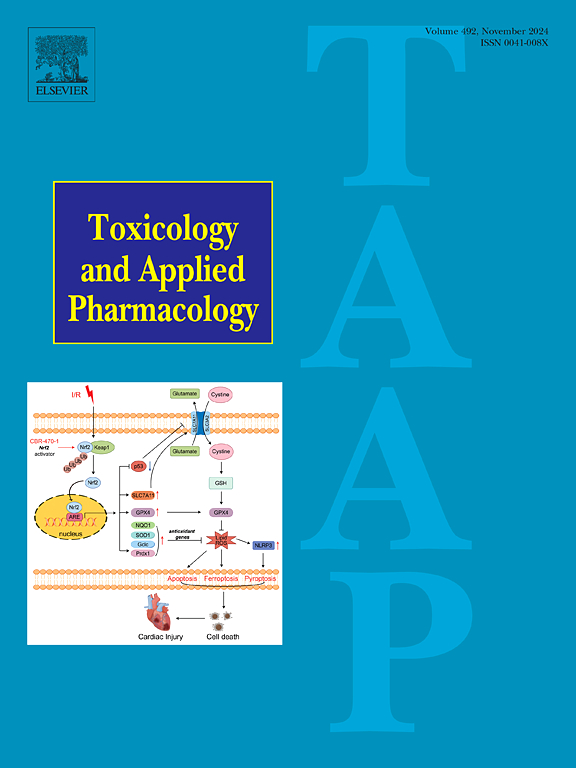Comparison of in utero phthalate exposure on fetal rat testis transcript and endocrine alterations with apical reproductive alterations in male rats
IF 3.3
3区 医学
Q2 PHARMACOLOGY & PHARMACY
引用次数: 0
Abstract
In utero administration of some diortho phthalate esters (PEs) produces reproductive tract malformations in male and female rat offspring via unknown molecular initiating events. Although the molecular initiating event(s) for these effects are unknown, the PEs consistently alter several key endocrine and gene expression events in the fetal male rat providing a signature of in utero PE exposure. We compared the dose-related alterations of in utero PE exposure on gene expression levels, measured with targeted RT-qPCR custom arrays, and ex vivo testosterone production (T Prod) with the reproductive alterations seen in F1 male rats from three different PE studies. The PEs studied included dicyclohexyl (DCHP) and dipentyl phthalate (DPeP) and a mixture study with five phthalates (DCHP, diethylhexyl (DEHP), dibutyl (DBP), butyl benzyl (BBP), and diisobutyl phthalate (DiBP)). These results demonstrate that targeted testis gene expression and/or T Prod data from short-term prenatal studies conducted during a critical window of fetal masculinization can be used to determine points-of-departure (PODs) for PEs and that these PODs are several fold more protective than the apical effects in postnatal animals. The clear linkage of these gene transcript and testosterone changes to the adverse effects of in utero exposure can facilitate acceptance of the use of gene expression and endocrine data to determine PODs for risk assessment. Furthermore, the use of gene expression and endocrine data from short-term in vivo fetal studies in place of multigenerational reproductive studies for POD determination for PE and mixtures of PEs could increase the rate of POD development for risk assessment and reduce use of animals and other resources.

子宫内邻苯二甲酸酯暴露对雄性大鼠胎鼠睾丸转录和内分泌改变及顶端生殖改变的比较。
在子宫内给药某些邻苯二甲酸二酯(PEs)通过未知的分子启动事件在雄性和雌性大鼠后代中产生生殖道畸形。尽管这些影响的分子启动事件尚不清楚,但PE持续改变了胎雄性大鼠的几个关键内分泌和基因表达事件,提供了子宫内PE暴露的特征。我们比较了子宫内PE暴露对基因表达水平的剂量相关改变,用靶向RT-qPCR定制阵列测量,体外睾酮分泌(T Prod)与来自三个不同PE研究的F1雄性大鼠的生殖改变。所研究的PEs包括二环己基(DCHP)和邻苯二甲酸二戊酯(DPeP),以及与五种邻苯二甲酸酯(DCHP、二乙基己基(DEHP)、二丁基(DBP)、丁基苄基(BBP)和邻苯二甲酸二异丁酯(DiBP))的混合物研究。这些结果表明,在胎儿雄性化的关键窗口期进行的短期产前研究中获得的靶向睾丸基因表达和/或T - Prod数据可用于确定pe的起始点(pod),并且这些pod在出生后动物中的保护作用比根尖作用高出几倍。这些基因转录和睾酮变化与子宫内暴露的不良影响之间的明确联系,有助于人们接受使用基因表达和内分泌数据来确定pod进行风险评估。此外,使用短期体内胎儿研究的基因表达和内分泌数据代替多代生殖研究来测定POD,以确定PE和PE的混合物,可以提高POD的发生率,以进行风险评估,并减少对动物和其他资源的使用。
本文章由计算机程序翻译,如有差异,请以英文原文为准。
求助全文
约1分钟内获得全文
求助全文
来源期刊
CiteScore
6.80
自引率
2.60%
发文量
309
审稿时长
32 days
期刊介绍:
Toxicology and Applied Pharmacology publishes original scientific research of relevance to animals or humans pertaining to the action of chemicals, drugs, or chemically-defined natural products.
Regular articles address mechanistic approaches to physiological, pharmacologic, biochemical, cellular, or molecular understanding of toxicologic/pathologic lesions and to methods used to describe these responses. Safety Science articles address outstanding state-of-the-art preclinical and human translational characterization of drug and chemical safety employing cutting-edge science. Highly significant Regulatory Safety Science articles will also be considered in this category. Papers concerned with alternatives to the use of experimental animals are encouraged.
Short articles report on high impact studies of broad interest to readers of TAAP that would benefit from rapid publication. These articles should contain no more than a combined total of four figures and tables. Authors should include in their cover letter the justification for consideration of their manuscript as a short article.

 求助内容:
求助内容: 应助结果提醒方式:
应助结果提醒方式:


